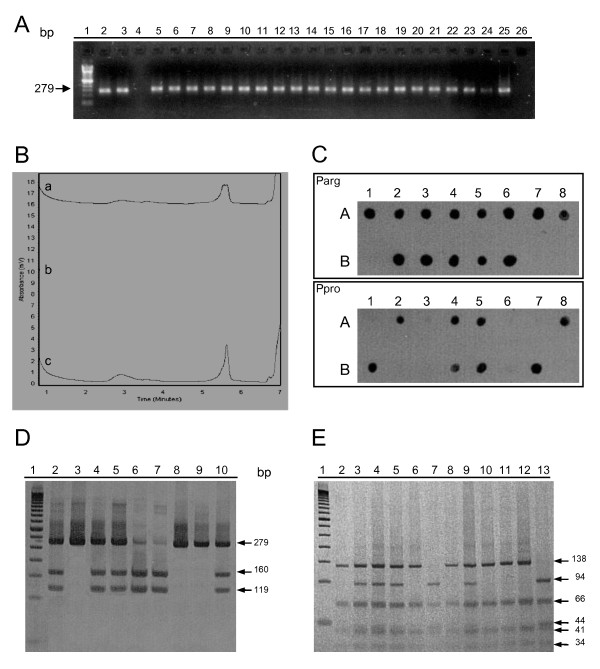Figure 1.
p53 codon 72 genotyping. (A) PCR for TP53 exon 4 detection. PCR products were loaded on 1.5% agarose gel. 100 base pairs DNA ladder (lane 1), positive controls (lane 2 and 3), negative controls (lanes 4 and 26), samples tested (lanes 5-25). (B) Detection of TP53 codon 72 polymorphism by DHPLC. Elution profiles obtained at 59°C. Representative heterozygous (a) and homozygous profile (b and c) are depicted. Note the small shoulder only in heterozygous samples. After the first trial, homozygous samples were mixed in approximately equimolar proportions with a control sample with TP53 codon 72 polymorphism previously identified as homozygous proline. This allowed differentiating the two homozygous genotypes. Homozygous profiles represent a sample with the genotype similar to the control sample added. Heterozygous profile represents a sample with the genotype differing from the control sample. (C) Dot Blot hybridization for TP53 codon 72 polymorphism genotyping. Samples were spotted onto nylon membranes and hybridized with biotin-labelled oligonucleotide probes for allele Arg (PArg) and allele Pro (PPro). Sample 1A, 1B and 2A represent positive controls. The profile observed in sample 1A is compatible with a homozygous arginine. Sample 1B presents a profile compatible with the genotype homozygous proline. Sample 2A presents a profile compatible with the heterozygous genotype. (D) Silver-stained 8% polyacrylamide gel showing the restriction profiles obtained with enzyme BstUI of the TP53 exon 4 PCR product. 50 base pairs DNA ladder (lane 1). Lanes 2, 4, 5 represent heterozygous samples where fragments of 279, 160 and 119 base pairs can be detected. Lanes 3 and 8 represent homozygous proline samples in which the enzyme was not able to digest the PCR product. Lanes 6 represent an homozygous arginine in which fragments of 160 and 119 base pairs can be identified. Lanes 7, 9 and 10 represent positive controls for homozygous arginine, homozygous proline and heterozygous samples, respectively. (E) Silver-stained 12% polyacrylamide gel showing the restriction profiles obtained with enzyme BsaJI of the TP53 exon 4 PCR product. 50 base pairs DNA ladder (lane 1). Lanes 3, 4, 5 represent heterozygous samples in which fragments of 138, 94, 66, 44, 41 and 34 base pairs can be detected. Lanes 7 represent a homozygous proline sample in which fragments of 94, 66, 44, 41 and 34 base pairs can be identified. Lanes 2, 6, 8, 10 and 11 represent homozygous arginine samples in which fragments of 138, 66, 41 and 34 base pairs can be detected. Lanes 9, 12 and 13 represent positive controls for heterozygous, homozygous arginine and homozygous proline samples, respectively.

